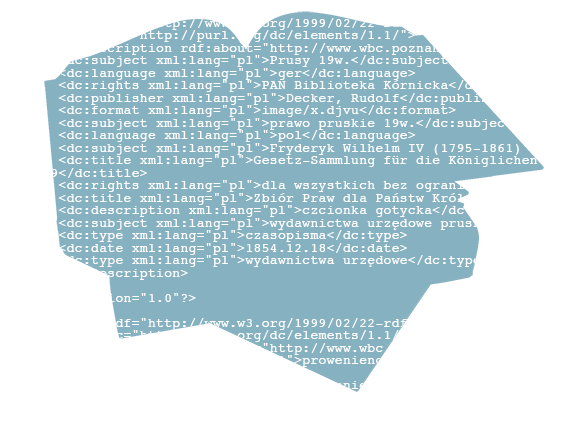Main features dArceo include:
 Storage and versioning of data
Every digital object sent to dArceo is properly stored and versioned. As a result, the user has full access to both the latest version of the object, as well as his previous form. dArceo can use different devices or data storage services, eg. local drive, disk array, or FTP / SFTP. In addition dArceo can be configured to cooperate in this regard with the service Archiving PLATON-U4, drop-in project PLATON and implemented within the framework of the national scientific network PIONIER.
Storage and versioning of data
Every digital object sent to dArceo is properly stored and versioned. As a result, the user has full access to both the latest version of the object, as well as his previous form. dArceo can use different devices or data storage services, eg. local drive, disk array, or FTP / SFTP. In addition dArceo can be configured to cooperate in this regard with the service Archiving PLATON-U4, drop-in project PLATON and implemented within the framework of the national scientific network PIONIER.
 Metadata management
dArceo uses METS format for storing complete information on the stored digital objects. Metadata file has a lot of information, including structural metadata, technical metadata, descriptive metadata and administrative metadata. In addition, metadata can either be supplied by the user (with master files) and extracted by the built-in dArceo mechanisms that use such tools to extract metadata as FITS, FFMpeg or DROID.
Metadata management
dArceo uses METS format for storing complete information on the stored digital objects. Metadata file has a lot of information, including structural metadata, technical metadata, descriptive metadata and administrative metadata. In addition, metadata can either be supplied by the user (with master files) and extracted by the built-in dArceo mechanisms that use such tools to extract metadata as FITS, FFMpeg or DROID.
 Repository OAI-PMH
Objects stored in dArceo can see through external systems interface protocol OAI-PMH. Currently supported are two formats share metadata: Dublin Core and METS.
Repository OAI-PMH
Objects stored in dArceo can see through external systems interface protocol OAI-PMH. Currently supported are two formats share metadata: Dublin Core and METS.
 Data transforming
The key feature of the system dArceo. There are three types of functions transform data. The first data migration functions, which play a key role in the context of long-term data storage. It is thanks to them it is possible to migrate the old format to the new without losing any information. These functions implement OAIS model transformation approach. The second type of function is to convert the data. These functions allow lossy conversion of data that can be used eg. To create a version of the presentation facilities available within the digital libraries. The third type of function is the advanced functions provide data that enables the delivery of source data (master files) in a personalized manner, eg. Progressive download, or displaying information on mobile devices.
Data transforming
The key feature of the system dArceo. There are three types of functions transform data. The first data migration functions, which play a key role in the context of long-term data storage. It is thanks to them it is possible to migrate the old format to the new without losing any information. These functions implement OAIS model transformation approach. The second type of function is to convert the data. These functions allow lossy conversion of data that can be used eg. To create a version of the presentation facilities available within the digital libraries. The third type of function is the advanced functions provide data that enables the delivery of source data (master files) in a personalized manner, eg. Progressive download, or displaying information on mobile devices.
 Data monitoring
dArceo monitors the stored data in terms of two aspects: the checksum (SHA-512) and the risk of data loss associated with being out of the use of data formats (determined on the basis of information from the database UDFR).
Data monitoring
dArceo monitors the stored data in terms of two aspects: the checksum (SHA-512) and the risk of data loss associated with being out of the use of data formats (determined on the basis of information from the database UDFR).
 Common space capability to convert data
One of the innovative aspects of the dArceo is that it allows sharing of data transformation functions. This means that the various institutions are prepared to share their services. This approach encourages cooperation on the broader digitization, and also helps in the implementation of the idea of long-term storage of data source. Ultimately institutions with a sufficiently high technical potential, will be able to provide migration services, conversion or advanced supply data to other, smaller parties.
Common space capability to convert data
One of the innovative aspects of the dArceo is that it allows sharing of data transformation functions. This means that the various institutions are prepared to share their services. This approach encourages cooperation on the broader digitization, and also helps in the implementation of the idea of long-term storage of data source. Ultimately institutions with a sufficiently high technical potential, will be able to provide migration services, conversion or advanced supply data to other, smaller parties.
We use cookies to ensure that we give you the best experience on our website. By using this website, you accept... terms and conditions in fullAccept










